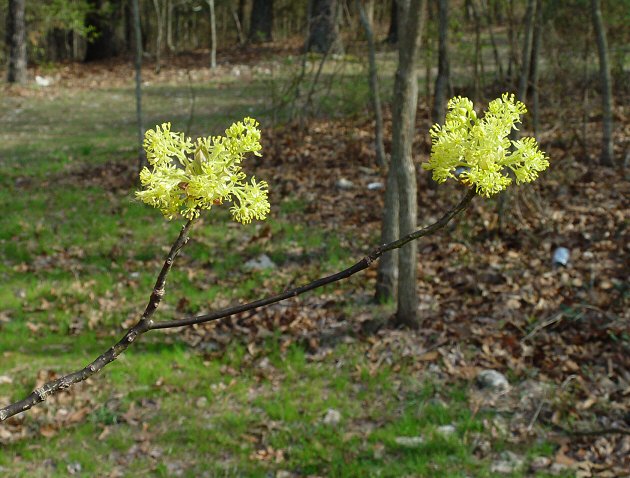Sassafras albidum (Nutt.) Nees
Sassafras

Native
CC = 2
CW = 3
MOC = 68
© DETenaglia
Sassafras albidum (Nutt.) NeesSassafras | |
 |
Native CC = 2 CW = 3 MOC = 68 |
© DETenaglia |
|
Family - Lauraceae Habit - Trees to 20 m or higher, dioecious, often colonial from root suckers. Stems - Twigs yellowish green to greenish brown (on older portions), glabrous or nearly so, producing a spicy aroma when broken or bruised. Winter buds sessile, ovoid or the lateral ones sometimes nearly globose, with a few overlapping scales. Bark coarsely and deeply furrowed, reddish brown to gray.
Leaves - Alternate, simple, entire, petiolate, often lobed. Petioles usually sparsely to moderately short-hairy. Leaf blades 3-12 cm long, variously all entire or with 1 or 2 large lobes, ovate to elliptic obovate in outline, long-tapered at the base, the blade or lobes angled or tapered to bluntly or sharply pointed tips; the exposed undersurface appearing strongly grayish and usually densely silky-hairy when young, the upper surface glabrous and often somewhat shiny at maturity, the undersurface pale and often somewhat glaucous at maturity, glabrous or sparsely to moderately short-hairy along the veins, the midvein with a pair of prominent, ascending branches from above the base (appearing 3-veined), the venation otherwise pinnate, with a network of fine veinlets between the secondary veins.
Inflorescences - Clusters of short racemes, these occasionally appearing umbellate, appearing terminal (but below the season's new leaves), produced as the leaves first begin to develop. Flowers short-stalked, the stalks elongating, becoming red and strongly bulbous-thickened toward the tip as the fruit matures.
Flowers - Tepals 3-4 mm long, slender, greenish yellow. Staminate flowers with 3 of the stamens having a pair of bulbous, orange nectaries at the base. Pistillate flowers with 6 staminodes, the ovary ovoid, the style elongate, expanded apically into an asymmetrical, sometimes slightly 2-lobed stigma.
Fruits - Dark blue drupes, appearing somewhat jointed to the tip of the expanded, red stalk, 7-10 mm long, ovoid to broadly ellipsoid, shiny, the stone 4-7 mm long, broadly ellipsoid, with the surface uniformly light to dark brown, with a pair of angled longitudinal ridges, otherwise appearing somewhat roughened or granular.
Flowering - April - May. Habitat - Forests, often along the margins, prairies, savannas, glades, bluffs, fence rows, fallow fields, roadsides, railroads. Origin - Native to the U.S. Lookalikes - None. Other info. - This common understory tree is found across the southeastern 2/3 of Missouri and the eastern half of the continental U.S. It is rare or absent to the north and west of Missouri. It is easily recognized by its furrowed bark and distinctive leaves, with nearly all trees producing leaves with 0, 1, and 2 lobes. Photographs taken at the Whetstone Conservation Area, Callaway County, MO., 2-25-04, and in the Piney Creek Wilderness, Mark Twain National Forest, Barry County, MO., 4-3-04 (DETenaglia); also at Little Lost Creek Conservation Area, Warren County, MO, 04-23-2014, 4-8-2020, and 4-14-2021, and Babler State Park, St. Louis County, MO, 06-13-2016 (SRTurner). |